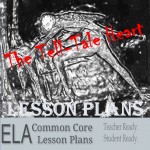Teaching literary criticism requires finding evidence in the story you’re critiquing. It makes sense, therefore, that writing a “Tell-Tale Heart” literary criticism requires important quotes from “The Tell-Tale Heart.”
You can also use these quotes for this literary quotes assignment.
And since a lot of these quotations deal with Poe’s fascination with death and the supernatural, I’ll throw in this American Romanticism lesson chart that would certainly help young scholars with a “Tell-Tale Heart” literary criticism as it pertains to American Romanticism: American Romanticism Lesson Plan.
Quote: “TRUE! — nervous — very, very dreadfully nervous I had been and am; but why will you say that I am mad? The disease had sharpened my senses — not destroyed — not dulled them.”
Analysis: A “Tell-Tale Heart” literary criticism must begin with the narrator, who claims he’s not mad. His actions and words, however, do not support this claim, as he contends he hears voices from hell and from inside the walls.
Oh, he also kills an old man, chops him up, and hides him under the floor. The narrator is obviously unreliable and his confession seems more an attempt to convince us he’s clever than anything else. This supports one of the primary themes in “The Tell-Tale Heart”: Different Versions of Reality.

Analysis: The eye is symbolic of the all-piercing eye of justice or as the old cliché states, “a window to the soul.” The American Romantics were interested in the study of mesmerism and hypnotic trances, which often made use of a eyes and watches and served as a method for learning the secrets of one’s soul.
Feel free to check out "The Tell-Tale Heart" lesson plans page. It's got some great lesson ideas. Or you could opt for the deluxe "Tell-Tale Heart" unit plan. Just click on the image to the left or the caption to get the full run down of what's in it.
Or you could ignore both and keep reading. It's the type of freedom the Internet affords.

Analysis: The police obviously suspect the narrator of a heinous crime. They most likely don't need to hear the beating of the dead man's heart, which the narrator is certain gives him away.
This is yet another example when the narrator's version of reality differs from what probably is reality.

Analysis: The home is supposed to be a sanctuary. The bedroom in one's home is supposed to be the safest of rooms in that sanctuary. The narrator was already on the list of worst roommates ever before he kills the old man.
And how has Poe remained the master of horror and suspense over a century after his death? Perhaps it's his willingness to explore a human's worst fears.
I'm not even going to mention the narrator's description of thrusting his head in and out, in and out of the old man's bedroom and what that might suggest.

Analysis: The narrator becomes Death personified, which is exactly the type of thing that happens to people who aren't mad, right?
The American Romantics were fascinated with death and the supernatural, Poe being at the forefront of such fascination.
A pervasive theme in Poe's works includes the inescapability of Death.

Analysis: Remember that American Romantic thing about fascination with death and the supernatural? The narrator sure has a fascination with death.
It's probable that the narrator includes this part in the story to show how clever he is. What it actually does is make him look more insane. Something you might want to bring up in your "Tell-Tale Heart" literary criticism on the narrator's different versions of reality.

Analysis: There are three prominent objects in "The Tell-Tale Heart": (1) The heart; (2) The eye; (3) The watch.
The narrator likens his movement to that of a clock. In a sense, he's a clock counting down the seconds of the old man's life.
There may also be a correlation between the eye, which watches; and a watch, which tells time. Or maybe not?

Analysis: I guess a "Tell-Tale Heart" literary criticism would be incomplete without mentioning—in this case, indirectly—the beating of the old man's heart.
In this example, the man's heart is compared to a clock, a clock which is ticking away the old man's life.
Quote: "Villains!" I shrieked, "dissemble no more! I admit the deed! --tear up the planks! --here, here! --it is the beating of his hideous heart!"
Analysis: I included this quote because it gives me chills. I'm sure there's some "the heart knows all" symbolism here. I recommend watching "The Tell-Tale Heart" movie, linked here. The third option is the best option and feeling the power behind this line.
Last Updated on November 17, 2016 by Trenton Lorcher
Share This:
